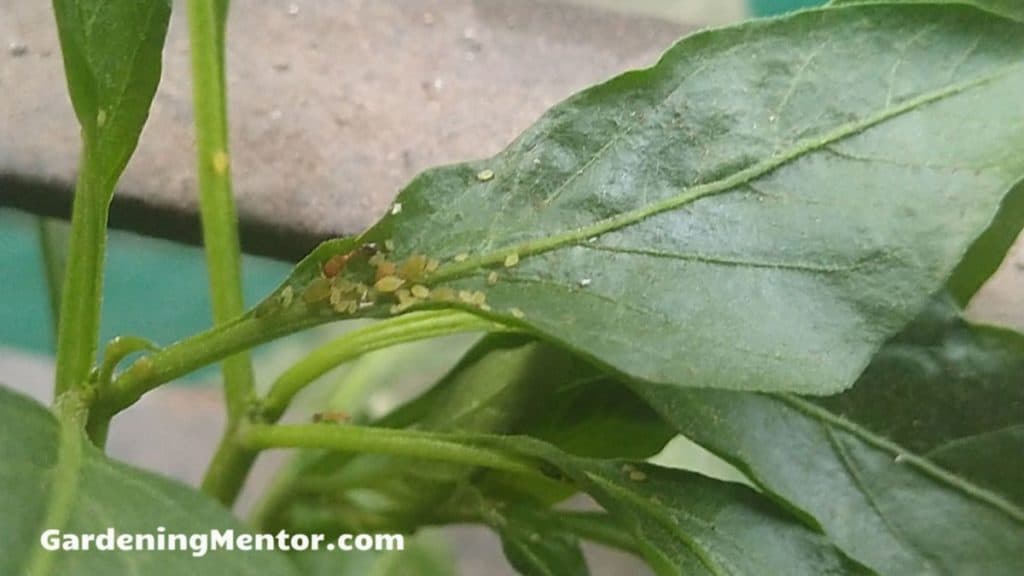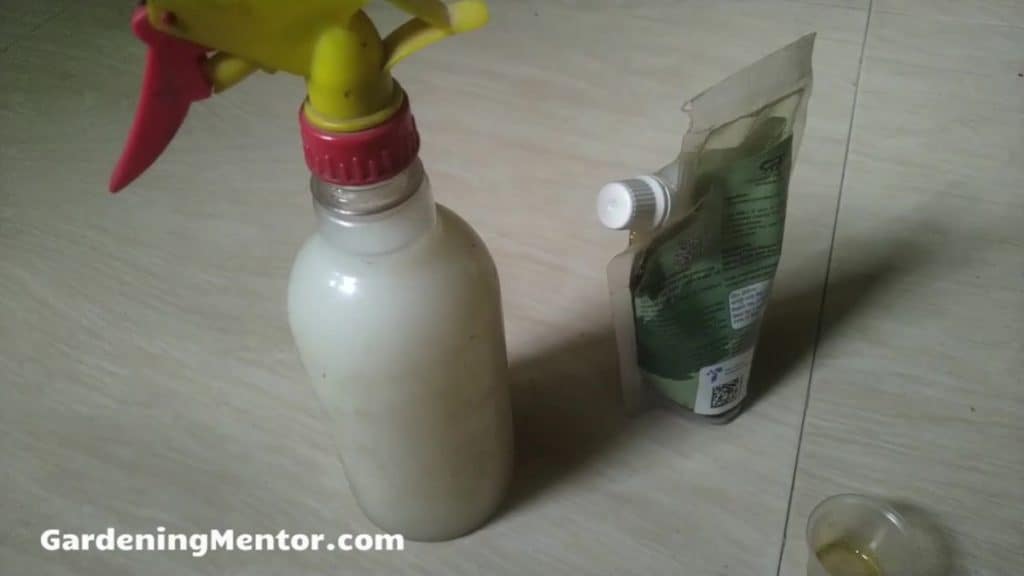I like to watch parsley grow with it’s luscious, green leaves. But once I had the problem that the leaves were turning white. I wanted to know what was causing this issue and how I could fix it.
Your parsley leaves are turning white because powdery mildew has attacked the plant. This is a fungal infection that leaves white spots on the plant. You can use milk to get rid of powdery mildew.
I’ve written all of my research in this post so you may find it useful if your parsley plants are facing the same problem.
1. It May Be Due to Fungi
One cause may be powdery mildew, a fungal disease likely to occur in gardens with high humidity, low soil moisture, overcrowding, excessive shade, or low air circulation.
This affliction begins by showing up on young leaves as blisters. The leaves then curl up afterward. Some manifestations look like talcum powder in varying shades from white to gray. If seriously infected, a plant’s young leaves will drop off.
2. It May Be Due to Bacteria
Bacterial leaf spot, caused by microscopic single-celled organisms, is one reason for white spots on parsley leaves. This condition manifests itself in different ways. In serious cases, the leaves not only discolor, but they also die. Spots appear on top of, underneath, or on the tips of leaves.
Leaf spot bacteria love wet, cool environments. They quickly spread to plants through infected seeds, plant debris in soil, from being splashed onto leaves by rain or overhead irrigation, or through farming equipment and people moving through the wet plants.
High humidity and mild temperature contribute to spore growth, thereby increasing the risk of infection. Other possible sources of infection include nearby plants.
3. Insects May Be the Culprits

Spider mites, aphids, or leaf miners produce white spots on leaves. White webs on parsley leaves may be the work of spider mites.
White spots that turn into holes may be done by caterpillars. Yellow, squiggly lines or blotches are made by the larvae of leaf miners (the most common are black flies).
Insect infestation is common in parsley, but should not be ignored. Otherwise, the plant can’t be harvested for food. Generally, the fastest way to curb insect infestation is to use pesticides. If you’re worried about the negative effects of pesticides, use organic kinds.
One natural way of killing leaf miners is to use insecticidal neem oil, which disrupts their natural life cycle. Another is to release “good bugs” like wasps called “Diglyphus isaea” into your crops. You can buy these leafminer natural enemies from nurseries.
4. It May Be a Soil Problem
The white spots may simply be a soil deficiency or lack of moisture, especially if the plant is in a pot. Take the plant out of its pot with all the roots intact.
Discard the old soil. Replant the parsley in a different pot with new soil or in a garden. It will regain its health within two to four weeks.
5. The Container Isn’t Big Enough
Wait until you see some new leaf growth before removing all affected leaves and stems. If there are new leaves, replant this part in a bigger container with new soil and slow-release fertilizer.
One gardener recommends one gallon or 3/4 gallon containers for parsley, which likes moist but well-drained soil. Ensure the soil has a pH (potential of Hydrogen)* near six.
6. The Ambient Temperature Is Too Cold
If the ambient air temperature around your parsley plant is too cold, the roots may not be able to absorb nutrients, especially iron. Use an atmospheric thermometer to monitor the temperature of your plants.
Make regular inspections. If possible, move outdoor plants temporarily indoors, put them in a greenhouse, or build temporary shelters to regulate the temperature.
7. They Need Harvesting
It is possible that your plant’s leaves are just dying a natural death. This is probably the case if the white-tipped leaves are mainly the outer, older leaves.
To solve this, use your parsley more frequently, but harvest the oldest leaves first—those coming from outside the rosette.
Regular harvesting will also minimize the occurrence of blemished or yellowing leaves and produce new greener, healthier ones.
8. They Need Fertilizing
Your plant may just need fertilizer. Do a soil test before next spring, especially if you haven’t done one in a couple of years. The test will reveal the missing nutrients. Add them as needed.
The recommendation is a fish/kelp emulsion. If the soil is acidic, it may lack iron. You can add Ironite plant fertilizer.
You may also want to lightly mulch some compost around your parsley and work it into the topsoil. Water well, and you should notice a difference in new growth.
9. They Have Windburn or Sun Scorch
Overexposure to wind or sun may not affect parsley’s quality for culinary use, but its aesthetics as a garnish may suffer—unless you’re going for the avant-garde.
The tips of the outermost leaves are the most susceptible. Sunscald looks like bleached-out patches around leaves. It will not kill leaves, but prolonged occurrences may cause leaves to drop.
Wind/sunburn is not specific to parsley and is normal for many plants, so it should not be a cause for worry, though they do damage plant cells. To protect parsley plants, place some wooden panels around them to block most of the elements.
10. They May Be Suffocating
Check if nearby plants are affecting your parsley. See if weeds are crowding it. Remove the weeds and relocate the offending plants. Then prune your parsley to encourage it to grow healthier leaves.
11. They Are Getting Old and Bitter
The National Gardening Association explains that it’s normal for the color of older leaves to fade, especially those from second-year plants. It’s part of their maturation process. The plants’ flower, set seed, then die.
The leaves of a stressed or second-year plant may taste bitter. This stress can come from dried out soil, excess heat, soil lacking in nutrients, or a combination of these.
12. They Are Suffering From Chlorosis
If the tips, stems, or branches of your parsley plant have turned completely white, it may be suffering from chlorosis. This means it is not producing enough chlorophyll to look green.
Chlorophyll uses sunlight to make food for plants, so if your plant doesn’t have enough of it, then it may be hungry.
Causes of Chlorosis
- Soil deficient in specific minerals (such as iron, magnesium, or zinc), nitrogen, or proteins
- Damaged and/or compacted roots
- Waterlogged roots caused by poor drainage, resulting in a soil pH unable to sustain nutrients
- The use of pesticides (particularly herbicides) meant to target weeds or treat crops
- Exposure to sulfur dioxide
- Damage caused by ground-level ozone
- Bacterial pathogens
- Fungal infection
How to Treat Parsley Leaves Turning White
- Ask a local master gardener to diagnose persistent or recurring problems.
- Collect a soil sample and have it tested.
- Change your soil.
- Do regular, thorough plant inspections.
- If your container isn’t big enough, use a bigger one. Better yet, transfer your parsley to a garden where it can grow freely.
- Use slow-release fertilizer.
- Treat fungal infestations with copper fungicide (or one made for edibles) at the first sign of infection. Follow the manufacturer’s instructions precisely. Infections should disappear in a few days to a week.
- If it’s an insect problem, wash your leaves with insecticidal soap.
- Combine cultural controls and potassium bicarbonate with organically certified crops.
- Whenever possible, plant disease-resistant seeds or seeds treated to reduce seed-borne diseases.
- Use drip irrigation instead of the overhead kind.
- Let your plants dry from dew, rain, or water before moving among them. The same goes for gardening or farming equipment.
- Promote air circulation by providing more room between susceptible plants.
- Practice good garden sanitation. Routinely remove crop debris.
- Rotate to non-host crops for at least four years in disease-ridden areas.
- Move wind-burned parsley to a more sheltered area (or build a perimeter around it). Remove damaged leaves.
- Give your plant an inch of water per week, depending on weather conditions. Be consistent with watering.
- To curb infestation or disease, mix two tablespoons of neem oil with one gallon of water in a spray bottle. Coat all sides of the plants completely. Apply every week until the affliction is gone, then reapply every 14 days for prevention.


Fact Checked, Written, and Published by Kevin Rodrigues
Kevin is the founder of Gardening Mentor, a website that aims to teach people to grow their own food in a limited space. As a self-taught gardener, Kevin has spent several years growing plants and creating gardening content on the website. He is certified in Home Horticulture and Organic Gardening from Oregon State University. He has a Post Graduate Diploma in Horticulture and Landscape Gardening from Mumbai University.
Read more
